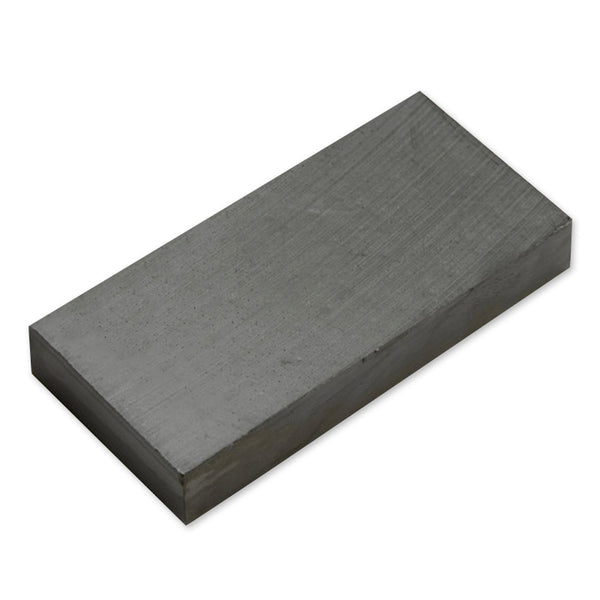Great service
Great prices and great service thank you
Product code: 12010


 Earn 68 points for this product with AMF Magnetics Perks
Earn 68 points for this product with AMF Magnetics Perks
Prices are GST Incl.
Request a Quote for Bulk OrdersAustralia's Leading Supplier
Shipping Worldwide*
30 Day Returns
Same Day Dispatch*

This ferrite block magnet has a 150mm length, a 100mm width and a height of 25.4mm. This ferrite magnet has a magnetic flux reading of 1966 Gauss and a pull force of 15.3 kg. It is identified by the AMF magnet part number 12010.
Travel by rail remains a popular and viable form of transport for people and all types of cargo, especially minerals and grains. Magnets of all kinds have played important functions in rail transport since the advent of the first locomotives in the nineteenth century. Magnets housed in wheel, brake and axle assemblies are used to regulate moving parts and deliver a smoother expression of mechanical power.
Magnets housed in rolling stock suspension systems and carriage linkages help moderate the forces and gyrations carriages travelling at speed are able to generate. Custom built machines, travelling on the same rails as the rolling stock are necessary for the cleaning, maintenance and repair of thousands of miles of track.
Some of these maintenance locomotives house powerful ferrite block magnets like these 150mm long, 100mm wide and 25mm in height, in order to attract, capture and secure some of the most dangerous forms of debris on rail tracks, large metal fragments.
These ferrite block magnets weigh only 1.8kg yet have a reliable brute pull force of 15.3 kg. Rail engineers and rail maintenance workers rely on the known pull force of these and other magnets as a reliable method to remove potential hazards from thousands of miles of rail tracks at the first pass. Derailments constitute a catastrophe, if not of loss of tragic loss of life, then of huge financial losses.
For most jobs, being sure of a work method or scope of works is good enough. For rail engineers and rail maintenance workers being sure is not enough. They have to know. With the help of ferrite block magnets plucking fragments of metal from the proximity of rail tracks across the country, they know.
Our large ferrite block magnets are often used in sweeping and separation applications. Any machining of ferrite blocks must be done with a diamond wheel, ideally before magnetisation, as they are hard and brittle.
No FAQ available

NB: Ranges are indicative for product category, please check individual products for specific values within that range.




This ferrite block magnet has a 150mm length, a 100mm width and a height of 25.4mm. This ferrite magnet has a magnetic flux reading of 1966 Gauss and a pull force of 15.3 kg. It is identified by the AMF magnet part number 12010.
Travel by rail remains a popular and viable form of transport for people and all types of cargo, especially minerals and grains. Magnets of all kinds have played important functions in rail transport since the advent of the first locomotives in the nineteenth century. Magnets housed in wheel, brake and axle assemblies are used to regulate moving parts and deliver a smoother expression of mechanical power.
Magnets housed in rolling stock suspension systems and carriage linkages help moderate the forces and gyrations carriages travelling at speed are able to generate. Custom built machines, travelling on the same rails as the rolling stock are necessary for the cleaning, maintenance and repair of thousands of miles of track.
Some of these maintenance locomotives house powerful ferrite block magnets like these 150mm long, 100mm wide and 25mm in height, in order to attract, capture and secure some of the most dangerous forms of debris on rail tracks, large metal fragments.
These ferrite block magnets weigh only 1.8kg yet have a reliable brute pull force of 15.3 kg. Rail engineers and rail maintenance workers rely on the known pull force of these and other magnets as a reliable method to remove potential hazards from thousands of miles of rail tracks at the first pass. Derailments constitute a catastrophe, if not of loss of tragic loss of life, then of huge financial losses.
For most jobs, being sure of a work method or scope of works is good enough. For rail engineers and rail maintenance workers being sure is not enough. They have to know. With the help of ferrite block magnets plucking fragments of metal from the proximity of rail tracks across the country, they know.
Our large ferrite block magnets are often used in sweeping and separation applications. Any machining of ferrite blocks must be done with a diamond wheel, ideally before magnetisation, as they are hard and brittle.
No FAQ available

NB: Ranges are indicative for product category, please check individual products for specific values within that range.




The Pull Force listed for each magnet is based on lifting 10mm thick steel from a horizontal surface. Magnets on a vertical surface (of 10mm thick steel) are generally able to hold around only 30% of the pull force listed in the product description. This is due to the effects of gravity and the lack of friction between the surface and the shiny magnet. Read More